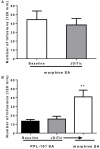In Vitro and In Vivo Profile of PPL-101 and PPL-103: Mixed Opioid Partial Agonist Analgesics with Low Abuse Potential
- PMID: 28446883
- PMCID: PMC5388777
- DOI: 10.3389/fpsyt.2017.00052
In Vitro and In Vivo Profile of PPL-101 and PPL-103: Mixed Opioid Partial Agonist Analgesics with Low Abuse Potential
Abstract
Opiates are still the most effective and widely used treatments for acute and chronic pain. However, the problems associated with morphine and other standard opioid analgesics severely limit their effectiveness in the clinic. PPL-101 and PPL-103 derived from morphine and morphinan ring systems contain a chiral N-substituent, which confers it with a unique combination of high-binding affinities and partial agonist activities at mu, delta, and kappa opioid receptors, leading to unique in vivo pharmacology compared to other conventional opioids. Acute antinociceptive and reward acquisition of PPL-101 and PPL-103 were assessed in mice using the tail flick assay and conditioned place preference (CPP) paradigm, respectively. The reinforcing effects of these compounds were assessed in rats using the self-administration paradigm. In mice, PPL-101 and PPL-103 produced antinociception reaching maximal effects that were equivalent to morphine at approximately 1/3 and 1/10 of morphine's dose, respectively. PPL-101-induced antinociception was attenuated following pretreatment with the kappa antagonist JDTic, but not the mu opioid antagonist beta-FNA. In mice, PPL-101 and PPL-103 produced dose-dependent decreases in activity, similar to other kappa agonists; however, they did not produce conditioned place aversion, and in fact elicited a trend toward CPP. In rats, neither PPL-101 nor PPL-103 were self-administered when substituted for morphine and PPL-101 attenuated morphine self-administration, when administered systemically prior to the self-administration session. Collectively, these results indicate that mixed opioid receptor partial agonists can produce potent antinociceptive activity with a lack of aversion in mice and without being self-administered in rats. Compounds with this profile could be superior analgesics with greatly reduced addiction liability and fewer side-effects compared to traditional opiates.
Keywords: analgesic; conditioned place preference; kappa opiate; non-addicting; self-administration.
Figures









Similar articles
-
PPL-103: A mixed opioid partial agonist with desirable anti-cocaine properties.Prog Neuropsychopharmacol Biol Psychiatry. 2022 Dec 20;119:110599. doi: 10.1016/j.pnpbp.2022.110599. Epub 2022 Jul 5. Prog Neuropsychopharmacol Biol Psychiatry. 2022. PMID: 35798174
-
Absence of conditioned place preference or reinstatement with bivalent ligands containing mu-opioid receptor agonist and delta-opioid receptor antagonist pharmacophores.Eur J Pharmacol. 2007 Jul 2;566(1-3):75-82. doi: 10.1016/j.ejphar.2007.02.040. Epub 2007 Mar 3. Eur J Pharmacol. 2007. PMID: 17383633
-
In vivo pharmacological characterization of SoRI 9409, a nonpeptidic opioid mu-agonist/delta-antagonist that produces limited antinociceptive tolerance and attenuates morphine physical dependence.J Pharmacol Exp Ther. 2001 May;297(2):597-605. J Pharmacol Exp Ther. 2001. PMID: 11303048
-
Competitive and non-competitive NMDA antagonists block the development of antinociceptive tolerance to morphine, but not to selective mu or delta opioid agonists in mice.Pain. 1996 Dec;68(2-3):229-37. doi: 10.1016/s0304-3959(96)03185-5. Pain. 1996. PMID: 9121809
-
Opioid peptide-derived analgesics.AAPS J. 2005 Oct 14;7(3):E560-5. doi: 10.1208/aapsj070356. AAPS J. 2005. PMID: 16353933 Free PMC article. Review.
Cited by
-
Opioid system and related ligands: from the past to future perspectives.J Anesth Analg Crit Care. 2024 Oct 11;4(1):70. doi: 10.1186/s44158-024-00201-2. J Anesth Analg Crit Care. 2024. PMID: 39390585 Free PMC article. Review.
-
Medications for substance use disorders (SUD): emerging approaches.Expert Opin Emerg Drugs. 2017 Dec;22(4):301-315. doi: 10.1080/14728214.2017.1395855. Epub 2017 Oct 30. Expert Opin Emerg Drugs. 2017. PMID: 29057665 Free PMC article. Review.
-
A2A Adenosine Receptor Partial Agonism Related to Structural Rearrangements in an Activation Microswitch.Structure. 2021 Feb 4;29(2):170-176.e3. doi: 10.1016/j.str.2020.11.005. Epub 2020 Nov 24. Structure. 2021. PMID: 33238145 Free PMC article.
-
Design of Analgesic Trivalent Peptides with Low Withdrawal Symptoms: Probing the Antinociceptive Profile of Novel Linear and Cyclic Peptides as Opioid Pan Ligands.ACS Chem Neurosci. 2023 Feb 1;14(3):506-515. doi: 10.1021/acschemneuro.3c00005. Epub 2023 Jan 18. ACS Chem Neurosci. 2023. PMID: 36651179 Free PMC article.
-
Brain Penetrant, but not Peripherally Restricted, Synthetic Cannabinoid 1 Receptor Agonists Promote Morphine-Mediated Respiratory Depression.Cannabis Cannabinoid Res. 2022 Oct;7(5):621-627. doi: 10.1089/can.2021.0090. Epub 2021 Dec 17. Cannabis Cannabinoid Res. 2022. PMID: 34935460 Free PMC article.
References
-
- Porreca F, Mosberg HI, Hurst R, Hruby VJ, Burks TF. Roles of mu, delta and kappa opioid receptors in spinal and supraspinal mediation of gastrointestinal transit effects and hot-plate analgesia in the mouse. J Pharmacol Exp Ther (1984) 230:341–8. - PubMed
-
- Howell LL, Bergman J, Morse WH. Effects of levorphanol and several kappa-selective opioids on respiration and behavior in rhesus monkeys. J Pharmacol Exp Ther (1988) 245:364–72. - PubMed
Grants and funding
LinkOut - more resources
Full Text Sources
Other Literature Sources
Research Materials

